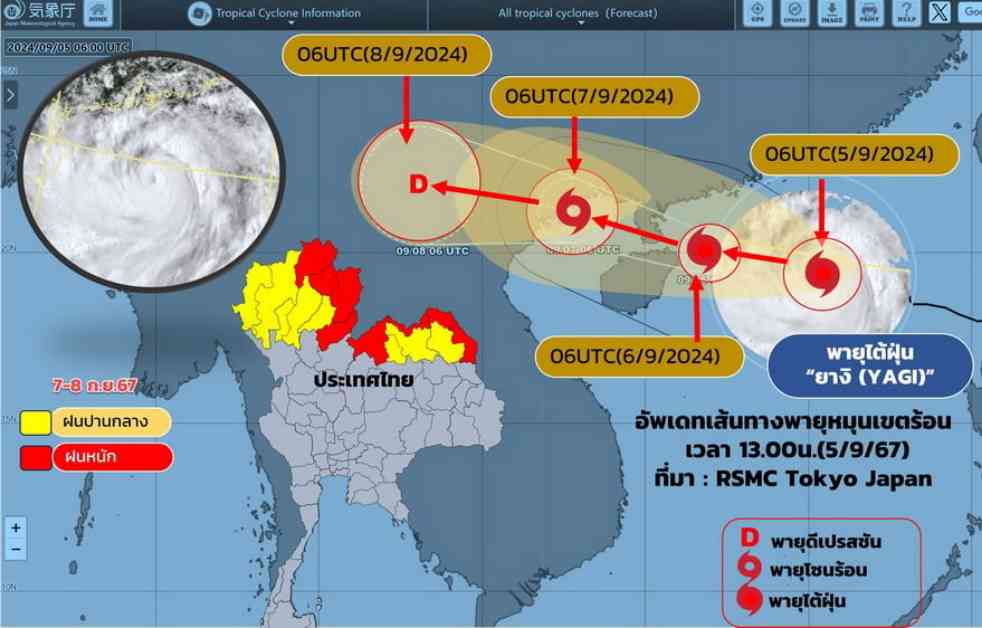Typhoon Yagi Update: Heavy Rain Expected in Multiple Provinces on September 7-8
The Department of Meteorology issued an update on Typhoon Yagi, indicating that the storm is currently located in the South China Sea, with its center east of the Hai Lham island approximately 510 kilometers away. The maximum wind speed near the center is about 195 kilometers per hour, and the typhoon is moving slowly in a westward direction. It is forecasted to pass through the Hai Lham island in China and make landfall in Vietnam on September 7-8. Subsequently, the intensity of the storm is expected to decrease.
Provinces Affected by Heavy Rainfall
The northern and northeastern provinces of Thailand are likely to experience heavy to very heavy rainfall, along with strong gusty winds on September 7-8. Additionally, the southwestern coast of Thailand and the Gulf of Thailand will also witness heavy rainfall. This weather pattern poses a risk of flash floods and mudslides in low-lying areas, especially near rivers and in mountainous regions.
Safety Precautions for Mariners
Mariners are advised to exercise caution and avoid sailing in areas with thunderstorm activity. Small boats in the South China Sea and the upper Gulf of Thailand should remain near the shore until September 8. The Department of Meteorology continues to monitor the typhoon’s path and analyze satellite images to provide timely updates.
Typhoon Yagi’s Current Status
As of September 5, Typhoon Yagi remains strong but is beginning to weaken as it moves slightly westward and northward. The storm is expected to pass through the Hai Lham island and the Gulf of Tonkin on September 6-7 before making landfall in southern China and northern Vietnam on September 7-8. It will further dissipate over northern Laos. Rainfall will occur along the storm’s periphery due to the low-pressure system weakening.
Provinces to Stay Alert
The northern provinces of Thailand, as well as the eastern regions and upper northeastern provinces, should remain vigilant as the storm’s path continues to evolve. Although the center of the storm has not yet entered Thailand, the surrounding areas may still experience strong winds and heavy rainfall. Graphic warnings have been issued for areas at risk of heavy rainfall on September 7-8, including Mae Hong Son, Chiang Mai, Chiang Rai, Lamphun, Phayao, Lampang, Nan, Phrae, Uttaradit, Phitsanulok, Nong Khai, Nong Bua Lamphu, Bueng Kan, Nakhon Phanom, Sakon Nakhon, and Udon Thani.
Preparedness Measures
Local authorities are advised to take necessary precautions to ensure the safety of residents in at-risk areas. Emergency response teams should be on standby to provide assistance in case of flooding or other weather-related emergencies. Residents are urged to stay informed about weather updates and follow official guidelines to stay safe during the storm.
Impact on Agriculture and Infrastructure
The heavy rainfall brought by Typhoon Yagi could have a significant impact on agriculture and infrastructure in the affected provinces. Flooding and landslides may damage crops, roads, and buildings, leading to disruptions in transportation and communication networks. Farmers are advised to take precautions to protect their crops, while authorities work to mitigate the impact on critical infrastructure.
Emergency Response and Relief Efforts
Government agencies and non-governmental organizations are preparing for possible emergency response and relief efforts in the event of severe weather conditions. Relief supplies, including food, water, and shelter materials, are being stockpiled in strategic locations to ensure a timely response to affected communities. Coordination between local, regional, and national authorities is crucial to effectively manage any potential disasters.
Community Preparedness and Resilience
Community preparedness and resilience play a vital role in minimizing the impact of natural disasters such as typhoons. Residents in high-risk areas should have emergency kits ready, including food, water, medications, and important documents. Evacuation plans should be in place, and residents should stay informed about evacuation routes and shelter locations. By working together and staying vigilant, communities can enhance their resilience to extreme weather events.
In conclusion, the update on Typhoon Yagi highlights the need for proactive measures to mitigate the impact of heavy rainfall and strong winds in multiple provinces. By staying informed, taking necessary precautions, and working together, communities can enhance their resilience and minimize the risks associated with severe weather events. It is crucial for authorities, residents, and organizations to collaborate effectively in preparing for and responding to potential emergencies caused by the typhoon.




















